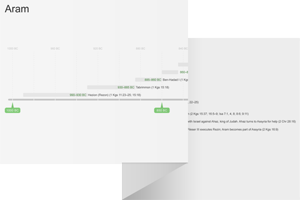17:1–14 This oracle—which focuses on Damascus, the capital of Aram (also called Syria)—recalls the crisis of chs. 7–8 (ca. 735 bc), where Aram and Israel jointly rebelled against Assyria and besieged Judah in an attempt to force them into their alliance. The overlapping imagery connecting Israel and Aram, and at times portraying Aram as almost part of Israel itself, is likely meant to emphasize the intertwined nature of these two powers at this time due to their alliance. |
17:1 An oracle of Damascus See note on 13:1. Damascus is the capital city of Aram (also called Syria), the nation north of Israel.
is the capital city of Aram (also called Syria), the nation north of Israel.
 Oracles Against the Nations Table
Oracles Against the Nations Table
a heap of ruins Assyria destroyed Damascus in 732 bc in response to the rebellion.
17:2 The cities of Aroer A common place name. One town named Aroer was located on the border of Moab with Ammon (Deut 2:36; Josh 13:16). This context might indicate that another Aroer may have been located near Damascus.
17:3 will disappear from Ephraim Following the initial pronouncement against Damascus, Israel and Aram (Syria) are blurred together. Ephraim was commonly used to refer to the entire northern kingdom of Israel. The poetic parallelism in Isa 17:3 equates the fortress of Ephraim with the kingdom of Damascus.
the remnant of Aram Allied in rebellion, the remnant of Aram (Syria) will receive the same fate as Israel. The language of “remnant” and “glory” is usually a sign of hope and potential restoration. The prophet skillfully undermines that expectation by expanding on what will really happen to the glory of Israel now that judgment is on its way: Aram will fall first, then Israel.
declares Yahweh of hosts This formula often concluded a prophetic oracle—giving the sense that the oracle against Damascus is complete and has ended with a glimmer of hope.
17:4 On that day Indicates the oracle will continue to mark the coming judgment.
this shall happen: On that day, the glory of Jacob will be brought low The “glory” appeared to be a positive attribute in v. 3, but is now revealed to be a representation of their pride. See 2:11.
17:5 a reaper gathers standing grain The coming judgment is compared to the harvest, when everything is cut down.
the valley of Rephaim A fertile farming area southwest of Jerusalem.
17:6 gleanings will be left over in it, as when an olive tree is beaten An allusion to the remnant of Israel, similar to 24:13.
17:7 mankind will look to its maker When judgment and destruction come, some will repent.
the holy one of Israel This title emphasizes God’s holiness. See note on 1:4.
17:8 the altars, the work of its hands The faith of the remnant is marked by a rejection of all forms of idolatry and an acknowledgement of Yahweh as the supreme Maker.
the poles of Asherah worship Wooden poles erected to worship the Canaanite goddess Asherah, possibly representing sacred trees or groves.
17:9 which they deserted Probably a reference to the Canaanites who deserted cities in their flight before the Israelites in the book of Joshua.
17:10 you have forgotten the God of your salvation When Israel trusted God, He gave them victory. Perhaps meant to recall the conquest successes. See note on v. 9.
you plant a vine of a foreigner Likely a reference to their alliance with Aram (Syria).
17:12 the roar of mighty waters A combination of images in vv. 12–14 presents the nations initially as instruments of God’s wrath (compare 13:3)—harbingers of watery chaos. It quickly inverts that image with an oracle of supernatural salvation reminiscent of God’s actions on behalf of Israel in the exodus (see Exod 14) and the conquest of the promised land (e.g., Josh 6).
17:13 tumbleweed before the storm The imagery of theophany often included elements of wind, cloud, and storm. God is present in the strong forces of nature.
often included elements of wind, cloud, and storm. God is present in the strong forces of nature.
 Theophany in the Old Testament
Theophany in the Old Testament
17:14 the fate of those who plunder us The oracles against the nations were likely intended to give Judah hope in the midst of destruction and chaos. Yahweh would ultimately deliver them—even if they first had to experience destruction, looting, and plundering.

|
About Faithlife Study BibleFaithlife Study Bible (FSB) is your guide to the ancient world of the Old and New Testaments, with study notes and articles that draw from a wide range of academic research. FSB helps you learn how to think about interpretation methods and issues so that you can gain a deeper understanding of the text. |
| Copyright |
Copyright 2012 Logos Bible Software. |
| Support Info | fsb |
 Loading…
Loading…


